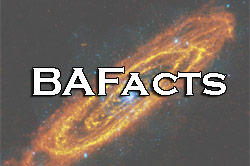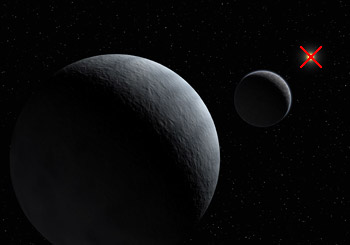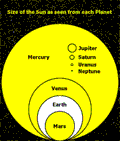 [On January 4, 2012, I started a new features: BAFacts, where I write an astronomy/space fact that is short enough to be tweeted. A lot of them reference older posts, but some of the facts need a little mathematical explanation. When that happens I’ll write a post like this one that does the math so you can see the numbers for yourself. Why? Because MATH!]
[On January 4, 2012, I started a new features: BAFacts, where I write an astronomy/space fact that is short enough to be tweeted. A lot of them reference older posts, but some of the facts need a little mathematical explanation. When that happens I’ll write a post like this one that does the math so you can see the numbers for yourself. Why? Because MATH!]
Today’s BAFact:
From Pluto, the Sun is so far away it would appear to be a point in the sky like a star, though an incredibly bright one.
Yesterday, I showed how the Sun would still be painfully bright even from Pluto, far brighter than the full Moon looks from here on Earth. But how big would it look in the sky?
It turns out, that math is even easier than it was to find the brightness! The size of an object on the sky depends on how big it really is, physically, and how far away it is. If you double the distance to an object, it will appear half the size. Easy peasy*.
So, as I established yesterday, on average Pluto is about 39 times farther from the Sun than the Earth, so if you were standing on Pluto (hopefully, in a well-heated and insulated spacesuit!) the Sun would appear 1/39th as big, or 0.026 times as big as it does from Earth.
What would that look like?
Well, the size of the Sun in the sky from Earth is about a half a degree – remember, there are 360° in a circle. So from the horizon to the zenith is 90°, and your outstretched fist is very roughly 10°. The Sun is about 0.5°, so you can block it with a single finger held at arm’s length.
From Pluto, though, it’s far smaller: less than 1 arcminute in size (a degree is divided into 60 arcminutes, so from Earth the Sun is about 30 arcmin across). That brings up an interesting point: the smallest size the human eye can easily resolve is something about an arcminute across. Anything smaller than that looks like a dot.
 So from Pluto, the Sun would look like a star – that is, a point of light – albeit an intensely bright one. Looking at it would certainly be painful, and probably make your eyes tear up.
So from Pluto, the Sun would look like a star – that is, a point of light – albeit an intensely bright one. Looking at it would certainly be painful, and probably make your eyes tear up.
But wait! I also mentioned yesterday that Pluto’s orbit is an ellipse, and it goes from 4.4 billion to 7.3 billion km from the Sun. That’s a factor of 29 to 49 times the Earths distance from the Sun. So that shrinks the size of the Sun accordingly. When Pluto is farthest from the Sun (called aphelion) the Sun is far less than an arcminute in size, and looks like a dot. When Pluto is closest to the Sun (perihelion) it will actually be just about one arcminute in diameter. Someone with sharp eyes might be able to perceive it as a disk rather than a point of light… though that would still be really tough to do, because the Sun’s still so bright. If you had a filter in your spacesuit visor you’d be able to see the disk of the Sun.
 If you’re curious, blogger Burton MacKenzie made a simple diagram showing how big the Sun is from each of the planets (thumbnail shown here; click to ensolarnate). He didn’t put Pluto on it, but from there the Sun would look even smaller on average than it does from Neptune.
If you’re curious, blogger Burton MacKenzie made a simple diagram showing how big the Sun is from each of the planets (thumbnail shown here; click to ensolarnate). He didn’t put Pluto on it, but from there the Sun would look even smaller on average than it does from Neptune.
Never forget: the solar system is big! The New Horizons probe was launched in early 2006, is screaming across the solar system at 15 km/sec (fast enough to cross the entire US in about 5 minutes!) but still won’t pass Pluto until mid-2015.
Space is deep, vast, and empty. From far enough away, even the Sun itself would be dimmed to invisibility. If there’s a life lesson in there somewhere, feel free to find it.
Image credit: ESO, annotated by me
* Well, almost easy peasy. This only works well if the object is far enough away that it appears small to you. There’s actually a trigonometric formula to do this exactly, but it hardly matters; for something the size of the Sun, even at Mercury’s distance, saying its apparent size changes linearly with distance is OK.